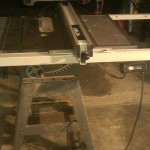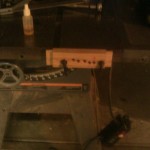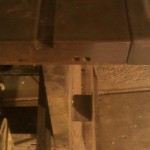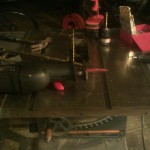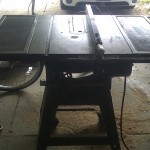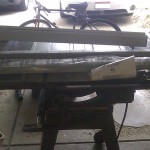Original Posted on November 3rd, 2010
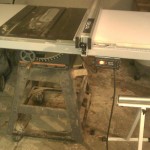 After a couple months of usage, the new fence is worked out great! One issue I noticed immediately was that the old stamped steel wings were no longer stable after removing some of the bolts to make the new fence fit. Plus with the longer rails, I felt like I was missing out on additional work area. So to the solve that problem I made two new wings. The left wing is roughly the same size as the old wing, while the right wing takes full advantage of the new rails.
After a couple months of usage, the new fence is worked out great! One issue I noticed immediately was that the old stamped steel wings were no longer stable after removing some of the bolts to make the new fence fit. Plus with the longer rails, I felt like I was missing out on additional work area. So to the solve that problem I made two new wings. The left wing is roughly the same size as the old wing, while the right wing takes full advantage of the new rails.
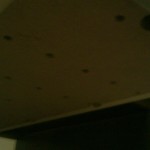 Construction was very straight forward. Looking at the bottom, while fuzzy, should give an idea of how it is constructed. The bulk of each wing is two pieces of 3/4″ mdf laminated together to make a surface that was 1 1/2″ thick. Notice all the screws on the bottom. Before any glue touched the MDF, I predrilled and prescrewed each screw to make the pieces lined up properly, and to make sure that the top piece didn’t lift away from the bottom during glue-up. After glue-up came the edge banding. The edge banding serves two purposes here. First it makes a clean looking edge. Second, and much more importantly, it provides the structure to bolt the wings to the saw and rails. I intentionally made the edge banding wider than 1.5″ and initially attached them proud of the top surface. I only attached two bands at a time using glue and nails. Once each of the bands were attached and the glue was dry, I flushed them up with the router using a flush trim bit. After completing the edge banding, I covered the top of each wing with a sheet of Formica, using contact glue and a j-roller.
Construction was very straight forward. Looking at the bottom, while fuzzy, should give an idea of how it is constructed. The bulk of each wing is two pieces of 3/4″ mdf laminated together to make a surface that was 1 1/2″ thick. Notice all the screws on the bottom. Before any glue touched the MDF, I predrilled and prescrewed each screw to make the pieces lined up properly, and to make sure that the top piece didn’t lift away from the bottom during glue-up. After glue-up came the edge banding. The edge banding serves two purposes here. First it makes a clean looking edge. Second, and much more importantly, it provides the structure to bolt the wings to the saw and rails. I intentionally made the edge banding wider than 1.5″ and initially attached them proud of the top surface. I only attached two bands at a time using glue and nails. Once each of the bands were attached and the glue was dry, I flushed them up with the router using a flush trim bit. After completing the edge banding, I covered the top of each wing with a sheet of Formica, using contact glue and a j-roller.
Finally came time for installation, and this was actually the most time consuming part of the project. After getting a wing lined up as close as possible, I would mark the two outer bolt holes. I then drilled the through hole. If you look in the picture around the edge you will see large holes in the bottom. These were drilled using a forstner bit, and then using a chisel and hammer, made a flat surface for the nut & washer to bite into. After cutting each of these (8 in all) a lot of time was spent with lining up with wings. This included widening the through holes with a rasp, tightening and loosening bolts, and finally some brute force with the rubber mallet. After finally getting everything even, I did a final check to make sure all the bolts were good and tight.
Update 3/6/2013 – I have been using the setup for not quite 2.5 years now. The wings have worked out fairly well, and do occasionally need readjustment. The fence has been great! I do try to keep the guides as clean as possible and well waxed. The fence still glides as smooth as the day I installed it. There was a point about a year ago that I thought I was going to have to replace the saw. Luckily the issue was repairable, and the saw is still useable. However, if I had to replace the saw, most likely that fence would have been put on the replacement saw.

